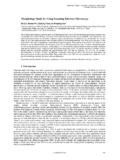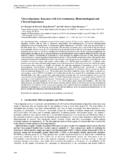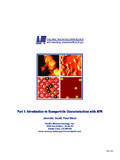Transcription of Applications of transmission electron microscopy …
1 Applications of transmission electron microscopy to virus detection and identification Vale1, Correia2, B. Matos2, JF Moura Nunes3 and Alves de Matos2,4 1 Faculty of Engineering, Catholic University of Portugal. Estrada Oct vio Pato, 2635"631 Rio de Mouro, Portugal. 2 Pathological Anatomy Department, Curry Cabral Hospital, Rua da Benefic ncia 8, 1069"166 Lisboa, Portugal. 3 electron microscopy , Portuguese Institute of Oncology, 1099"023 Lisbon, Portugal. 4 Center for Environmental and Marine Studies, University of Aveiro, Campus Universit rio de Santiago, 3810"193 Aveiro.
2 The size of viruses is with a few exceptions (the mimiviruses, poxviruses and some iridoviruses) below the resolution of the optical microscope. The 1000 times higher resolution of the transmission electron microscope (TEM), compared with the light microscope, allows direct observation of small virus particles. The improvement of both TEM equipment and technical procedures allows quick preparative methods and diagnosis of viruses at the family and genus level. Besides routine diagnosis this approach may prove essential to the identification of emerging pathogens in animals and humans.
3 A review of the literature and a description of the main methods and Applications of TEM to virus diagnosis and characterization are presented. Keywords transmission electron microscopy ; virus; diagnosis 1. Introduction Virus diagnosis by electron microscopy is based on the visualization and morphological identification of virus particles in samples of diseased tissues or organic fluids [1"3]. Before the advent of electron microscopy , viruses were only known by their manifestations, especially their capability to induce disease in susceptible hosts.
4 Because of their small size they can not usually be imaged with a conventional light microscope, and their particulate nature is apparent only indirectly through filtration and ultracentrifugation experiments [4, 5]. This fact set the stage for the rapidly growing interest in viruses as soon as the electron microscope was invented [6]. The approach met with great success since viruses, with their small size and particulate nature, were almost ideal samples for early transmission electron microscope (TEM) observations.
5 In fact, the development of the microscope by Ernst Ruska was heavily influenced by the observations of viruses carried out by his brother Helmut during the early stage of development of the methodology [5]. An historical review of the field was recently made by Roingeard [7]. The use of electrons for imaging allows the achievement of a resolution of about nm that can be used to visualize macromolecules, such as the capsid proteins or the nucleic acids of viruses. However, the need for high vacuum, thin specimens, and the very high energy of the electron beam irradiating the specimen placed terrible constraints to the kind of objects that could be visualized with the instrument [6].
6 Decades of technical advances that continue today, were needed to observe the macromolecular world in a state of preservation close to the living one [8, 9]. The accumulated knowledge on virus ultrastructure formed the grounds for the first classification of viruses based on virus intrinsic properties rather than on host characteristics and diseases produced by them [10]. As mentioned before, direct morphological observation of most virus particles is not possible with conventional light microscopy combined with immunocytochemical methods, that can reveal the nature of the viral antigens and their intracellular distribution, and constitutes a very powerful diagnostic method in virology [11].
7 Molecular or immunological methods, such as PCR (Polymerase Chain Reaction) and ELISA (Enzyme Linked Immuno Sorbent Assay), are very effective in detecting known viruses and can be used to scrutinize a large amount of samples. Nontheless, for new or unknown pathogens that may occur in the context of bioterrorism attacks or as a result of the manifestation of new pathogens, electron microscopy remains the only method that can provide a quick assessment of all pathogens present in a sample, providing an open view , which is why electron microscopy is considered a catch"all method [2, 3, 12, 13].
8 electron microscopy can also be used to investigate viruses isolated in cell cultures, which is useful in controlling the results of the virus isolation process, among other Applications [3]. In this paper we aim to lay down a few useful guidelines for those wishing to use electron microscopy in the context of virus diagnosis, on the basis of personal experience with human and veterinary samples and information from relevant literature. 2. Overview of the transmission electron microscope The resolution of a compound microscope is limited to half of the wavelength of the radiation used for imaging.
9 This limits the light microscope to a maximum resolution of 200 nm, when using visible light with a wavelength of 400" microscopy : Science, Technology, Applications and Education A. M ndez-Vilas and J. D az (Eds.)128 FORMATEX 2010_____ 800nm. The limited resolution of the light microscope only allows the observation of the general morphology of bacterial cells and extra"large viruses. The internal structure is not clearly observed by light microscopes. Bacteria dimensions range from 100 to 200 nm for the smallest bacteria ( some members of Mycoplasma, which equals the large"sized poxvirus), to 7 Dm in diameter for the largest sized specimens ( cyanobacterium Oscillatoria, with the same size as a red blood cell), including medium sized bacteria with Dm by to long ( Escherichia coli).
10 In summary, bacteria can be observed using a light microscope, but subcellular bacterial structures, bacterial appendages, and most viruses are not usually visible since their largest dimension is smaller than Dm [14]. A huge improvement in resolution is achieved with TEM by replacing the large wavelength light beam with an electron beam that has a wavelength of approximately nm. When using TEM, electron beams generated either by a tungsten or LaB6 filament, or by a field emission gun, substitute visible light.









